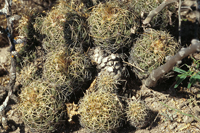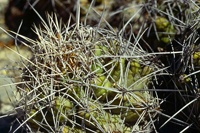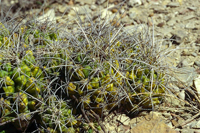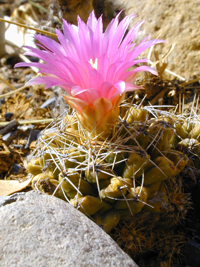Basionym: Thelocactus leucacanthus var. schmollii Werderm., Blüh. Kakt. and. sukk. Pfl. 5: Taf. 160 (1939).
Lectotype: Blüh. Kakt. and. sukk. Pfl. 5: Taf. 160 (1939), E.F. Anderson, Bradleya 5: 62 (1987).
Synonyms: Thelocactus krainzianus Oehme, Beitr. Sukk-Kunde Pflege 1 (1940). Thelocactus leucacanthus var. schmollii fa. krainzianus (Oehme) Nagl, Kakt. and. Sukk. 42: 183 (1991). Thelocactus sanchezmejoradai Meyrán, Cact. Suc. Mex. 3: 77 (1958). Thelocactus leucacanthus var. sanchezmejoradai Backeb., Die Cactaceae V: 2817 (1961).
Description
Stem commonly clustering, globose or ovoidal, 7-10 cm tall, 5-7 cm wide. Ribs 8-13, distinct. Tubercles rounded. Areoles with glands. Central spines 1-3, 10-55 mm long, ochre to greyish, straight, acicular. Radial spines 8-19, 10 mm long, ochre to greyish, straight, acicular. Flowers 40-90 mm wide, magenta. Seeds 1.8 x 1.4 mm, testa cells tabular with a verrucose surface sculpture.
Distribution
Mexico, Guanajuato and Querétaro, in a small area north of Vizarrón de Montes, occurring in matorral xerofilo on limestone hills at elevations of 1300-2000 metres above sea level, in the southern disjunct extension of the Chihuahuan Desert.
Comments
This subspecies is remarkable for its magenta flowers, which is the character that makes it distinguishable from the type.
Sanchezmejoradai is only a re-description of schmollii.
Krainzianus has been considered for many years as an uncertain species, but after the description of Thelocactus tulensis it has been thought possible to identify krainzianus with it. Nevertheless, matudae does not fit the description of krainzianus, mostly because of the lack of a lateral groove on the tubercles. A closer observation of the northern populations of schmollii has led to the opinion that is possible to identify these plants with the krainzianus of Oehme. The plants of this area fit well the description given by Oehme, have 8 ribs, are clustering and, above all, have the tubercles cross-grooved at the base, characters that do not belong to matudae. The presence of a cross-groove on the tubercles is a typical character for this entity, which can be found between Peña Blanca and Peñamiller, but can occasionally appear both in leucacanthus and schmollii. The latter taxon grows near Vizarrón de Montes, differing from krainzianus also in the size of tubercles, that are smaller, and in the greater number of radial spines, but I think that these differences are not sufficient to separate krainzianus from schmollii.
 The lectotype of Thelocactus leucacanthus var. schmollii Werderm.
The lectotype of Thelocactus leucacanthus var. schmollii Werderm. Thelocactus leucacanthus ssp. schmollii
Thelocactus leucacanthus ssp. schmollii Thelocactus leucacanthus ssp. schmollii "krainzianus"
Thelocactus leucacanthus ssp. schmollii "krainzianus" Thelocactus leucacanthus ssp. schmollii "krainzianus"
Thelocactus leucacanthus ssp. schmollii "krainzianus" Thelocactus leucacanthus ssp. schmollii
Thelocactus leucacanthus ssp. schmollii